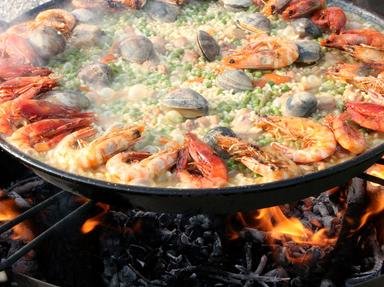Quiz Answer Key and Fun Facts
1. Gazpacho is a soup made of blended vegetables, with the main ingredient being tomatoes and stale bread. It is commonly associated with Andalusia, but is consumed all over Spain. Is it traditionally served hot or cold?
2. Paella is one of Spain's signature dishes and is made with rice cooked in a large shallow pan. From which region of Spain does paella originate?
3. While Italians have bruschetta, Spain has pan tumaca, or bread with tomatoes. From which region of Spain does it originate? (Hint: the locals call it 'pa amb tomàquet'.)
4. Depending on whether you're in Mexico or Spain, which word can mean either a flatbread made with maize, or an omelette like this one?
5. Jamón ibérico, or Iberian ham, is a cured meat eaten in Spain and Portugal. What colour is the breed of pig traditionally used to make Iberian ham?
6. Pictured here is gambas al ajillo, a tapas dish. You can probably guess that 'gambas' means 'prawns', but what does 'ajillo' mean?
7. Now it's time for some puddings. This custard pudding here is a caramel flan, one of my favourite puddings. Which of these is NOT a common flan ingredient?
8. These fried pastry treats, sprinkled with cinnamon sugar, are churros. They are street foods and also sold at festivals like Primavera Sound. What flavour sauce often accompanies them?
9. Pictured here are Peruvian alfajores, a pair of shortbread biscuits sandwiched together with dulce de leche. Spain also has a treat called an alfajor, from Andalusia, but it looks slightly different to the South American kind. Which of these answers does NOT describe Spanish alfajores?
10. Sangria is a sweet mixture of red wine and chopped fruit, often served in big pitchers with a slice of lemon. It is of both Spanish and Portuguese origin, and is popular with tourists. However, according to European Union law, can sangria be sold as sangria outside these countries?
Source: Author
Kankurette
This quiz was reviewed by FunTrivia editor
Bruyere before going online.
Any errors found in FunTrivia content are routinely corrected through our feedback system.

